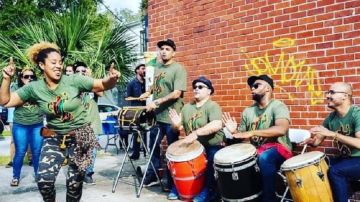Bomba & Plena Music Are Giving A New Voice to Afro-Latinx Communities
The uniquely Puerto Rican musical styles of bomba and plena are deeply rooted in the island’s African roots

Photo: Instagram/ @bombaconbuya
The uniquely Puerto Rican musical styles of bomba and plena are deeply rooted in the island’s African roots. When most Boricuas hear the deep drum beats of bomba and plena, we can’t help but move our bodies. When we hear the sound of the barilles or panderos, our hips sway and our shoulders shake and we feel something deep down inside of us that no matter where we are in the world, seems to pull us toward home. Puerto Rico’s African heritage is a proud one. Colorism aside, Puerto Rican culture is defined by our African ancestors, and for many generations, bomba and plena have been the creative outlets for Afro-Boricuas throughout the island and stateside. Now, in an age when the injustices committed against Black people are in the forefronts of our collective consciousness, these musical stylings have been resurrected as a form of resistance.
Plena, which is said to have originated in the city of Ponce, is a variety of folk music that largely became popular thanks to Afro-Latinx artists like Ismael Rivera and Rafael Cortijo, but it takes just one listen to deduce that its roots are African simply because of the distinct sound of the animal-skin drums. Traditionally, plena songs are a retelling of events—each song is a diary entry of sorts, in which the singer details the struggles and trials of daily life, and have long included often scathing political commentaries.
Bomba on the other hand, is less about the lyrics and more about the expression of emotions, and thusly it is inextricably connected to dance. Said to have come from West Africa, its roots lie within the city of Loiza which has always had a large community of African descendants. At the time of its inception, slaves were not allowed to worship their ancient gods and so they took their ancestral customs and used them to worship Christian saints.
In modern times, both bomba and plena have become a way for younger generations—many born and raised stateside—to connect to their heritage. The music has endured, we grew up listening to the beats and rhythms as our parents cooked and cleaned and did yard work and now we hear it and it’s become a siren song for our Afro-Boricua roots. We see it on viral YouTube and Instagram videos and feel a surge of pride and have a sense of belonging that’s almost impossible to explain.
Despite everything the slaves that were brought to the island endured, they left a lasting musical legacy that has become an integral part of the culture not just in Puerto Rico, but for Puerto Ricans throughout the world, so much so that famous Boricuas like Ricky Martin and Marc Anthony have infused their music with the very same African flavor the styles helmed. But possibly even more importantly, there is a small, modern movement surrounding these styles that runs deep and strong. From tiny neighborhood groups performing at Puerto Rican street festivals and political protests to bands and dance troupes in cities throughout the U.S. using the music as a creative outlet and cultural connection, bomba and plena are providing many with a unique and powerful voice.
“We have a responsibility to honor those who came before us and not forget them. Not allow for our traditions to fade and die,” Roberto Perez co-director of the Chicago-based bomba group Bomba con Buya tells HipLatina. Perez co-founded Bomba con Buya in 2009 along with a culinary education initiative called Urban Pilón, with the mission of preserving Caribbean and Latin American food traditions. He says he first saw live bomba at the age of 17, and it’s been an important part of his life ever since.
“It’s a music that works against all the commercial shit we are fed on the radio. I’m glad that in Chicago we could bring light of this music which was suppressed for so long,” he said. “For many of us it helped build our identity as Puerto Ricans away from the island. But this music has its parallel genres as well which can be found in the foundations of jazz in Nola with bambula, in Cuba with Tumba Francesa, in Guadeloupe with Gwoka, in Central America with the Garifuna tradition music. There is a link which connects many of us. For me personally it provided a sense of belonging. And I think we can provide to our youth what we have been given. With Buya we’ve created a family,” Roberto who explained capturing the essence of why we believe these traditional styles of music have become something of a siren song for Afro-Caribbeans living in the U.S.
Beyond that, we know that this music unifies us with our Black brothers and sisters suffering through horrific injustices and has allowed us as an Afro-Latinx community to rally behind those struggling both emotionally and physically with the effects of centuries of pain and abuse. Art undeniably has the power to draw humans together, and when the art form tangibly links two sets of people with shared backgrounds, especially in a time of need, it is especially profound.
Knowing that, there’s a sense of pride in being able to pass down these musical traditions to future generations who will hopefully continue to feel empowered and united by something that was created so long ago in the hopes of simply bringing something from home to offer comfort and an opportunity for both personal and political expression.

















